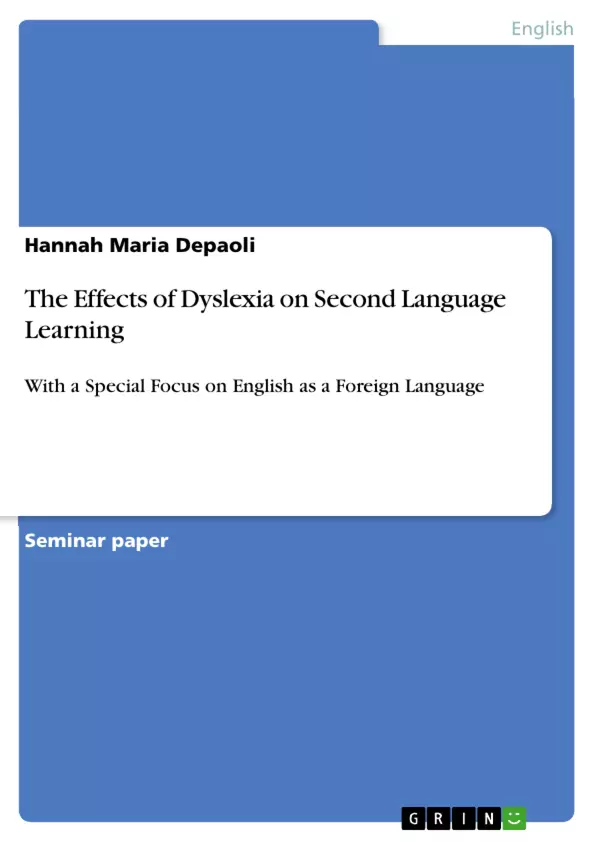After a general overview on Dyslexia, defining it as an impairment of the ability to recognize and comprehend written language, accompanied by difficulties in writing and spelling as well as slow reading and reduced reading comprehension, general facts about the deficit are presented, such as its prevalence and its official definition in the international ICD-10 catalogue.
With regard to the effects of Dyslexia on foreign language learning the topic of orthographies is discussed and various examples for transparent and less transparent orthographies are provided, as several studies have suggested that the transparency of an orthography determines the ease and speed of reading and writing in a language. The orthography of the German and English language are discussed and differences in transparency are pointed out. German, having a rather transparent orthography, i.e. clear-cut grapheme-phoneme correspondences, is easier to adapt to than English, which has a deep orthography with irregular grapheme-phoneme correspondences.
The fact that English is an obligatory subject in most curricula makes it essential to find ways to deal with its inconsistency and to design helpful material for both, normally developing and dyslexic students. Several findings about the effects of Dyslexia on foreign language learning are relevant for the foreingn language classroom. Implications for teaching techniques, material and lesson planning are discussed in this paper.
Table of Contents
- Introduction
- Dyslexia
- What is Dyslexia?
- Characteristics of Dyslexia
- Types of Dyslexia
- Acquired Dyslexia
- Developmental Dyslexia
- Prerequisites for the acquisition of literacy and deficits caused by dyslexia
- The Effects of Dyslexia on Foreign Language Learning
- Dyslexia in different orthographies
- Orthographic transparency
- Phonological and orthographic differences between German and English
- Dyslexia in different orthographies: studies and hypotheses
- The phonological deficit hypothesis
- Differences in reading strategies and differences in the speed of literacy acquisition
- The developmental model
- Dyslexia and Foreign Language Learning
- Types of Errors in the learning process of a Foreign Language
- Difficulties of dyslexics in Foreign Language Learning
- Suggestions for dyslexia friendly language lessons
- Conclusion
Objectives and Key Themes
This seminar paper aims to explore the effects of dyslexia on foreign language learning, particularly focusing on English as a foreign language. The paper will begin by defining dyslexia, outlining its characteristics, and examining different types. It will then delve into the complexities of dyslexia in different orthographies, examining the impact on reading and writing acquisition. Finally, the paper will analyze the challenges dyslexic learners face in acquiring foreign languages, and offer suggestions for creating dyslexia-friendly language lessons.
- Definition and characteristics of dyslexia
- Impact of different orthographies on dyslexia
- Specific difficulties dyslexic learners face in acquiring foreign languages
- Strategies for supporting dyslexic learners in language classrooms
- Potential for improving learning outcomes for dyslexic learners
Chapter Summaries
The first chapter introduces the concept of dyslexia, outlining its historical understanding and the evolution of research in this field. It also touches upon the challenges faced by dyslexic individuals in various aspects of life due to their learning disabilities. The chapter highlights the need for further exploration into the effects of dyslexia on second language acquisition, particularly in the context of English as a foreign language.
Chapter two provides a comprehensive definition of dyslexia, outlining its main characteristics and highlighting the difficulties in diagnosis. This chapter also explores different types of dyslexia, differentiating between acquired dyslexia resulting from neurological damage and developmental dyslexia, which is present from childhood.
The third chapter focuses on the impact of dyslexia on foreign language learning. It examines how different orthographies influence the learning process for dyslexic individuals, particularly focusing on the differences between German and English. The chapter also discusses various studies and hypotheses regarding dyslexia in different orthographies, exploring different theoretical models explaining the challenges faced by dyslexic learners.
Chapter four specifically addresses the difficulties dyslexic individuals encounter in foreign language learning. This chapter delves into the types of errors that dyslexic learners often make, outlining the specific challenges they face. The chapter concludes with practical suggestions for creating language lessons that are more accessible and supportive for dyslexic learners.
Keywords
This seminar paper centers around the core concepts of dyslexia, foreign language learning, orthographic transparency, phonological awareness, and the difficulties dyslexic learners face in acquiring second languages. The paper also explores the potential for creating effective language learning strategies for dyslexic students, aiming to improve their learning outcomes in foreign language classrooms.
- Quote paper
- Hannah Maria Depaoli (Author), 2015, The Effects of Dyslexia on Second Language Learning, Munich, GRIN Verlag, https://www.grin.com/document/322469



